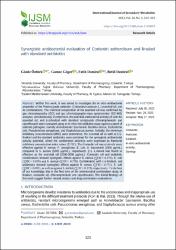Synergistic antibacterial evaluation of Coriandri aetheroleum and linalool with standard antibiotics
Künye
Öztürk, G., Göger, G., Demirci, F., & Demirci, B. (2023). Synergistic antibacterial evaluation of Coriandri aetheroleum and linalool with standard antibiotics. International Journal of Secondary Metabolite, 10(3), 323-331.Özet
Within this work, it was aimed to investigate the in vitro antibacterial properties of the Pharma grade coriander (Coriandrum sativum L.) essential oil, and its combinations. The chemical composition of the essential oil was confirmed by gas chromatography (GC) and gas chromatography-mass spectrometry (GC-MS) analyses, simultaneously. Furthermore, the potential antibacterial activity of both the essential oil, and (+)-linalool with standard compounds chloramphenicol, and ciprofloxacin were evaluated using an in vitro microdilution assay against a panel of selected pathogens, namely Acinetobacter baumannii, Bacillus cereus, Escherichia coli, Pseudomonas aeruginosa, and Staphylococcus aureus. Initially, the minimum inhibitory concentrations (MIC) were determined, the essential oil as well as (+)-linalool and the standard antibiotics were combined for the synergistic antibacterial activity potential, where the combination activities were expressed as fractional inhibitory concentration index values (Σ FIC). The Coriander oil was relatively more effective against B. cereus, P. aeruginosa, E. coli, A. baumannii (2500 µg/mL) compared to S. aureus (5000 µg/mL), respectively. (+)- Linalool was found as effective as the essential oil (2500-5000 µg/mL). Coriander oil and antibiotic combinations showed synergistic effects against B. cereus (∑FIC= 0.375), E. coli (∑FIC= 0.078) and S. aureus (∑FIC= 0.375). Combination with (+)-linalool, and antibiotics showed synergistic effects against B. cereus (∑FIC= 0.375), E. coli (∑FIC= 0.093), as well as against S. aureus (∑FIC= 0.375), respectively. To the best of our knowledge, this is the first time of the antimicrobial combination study of linalool, coriander oil, chloramphenicol, and ciprofloxacin. The initial findings of this work suggest further natural product and drug combination evaluations.
















